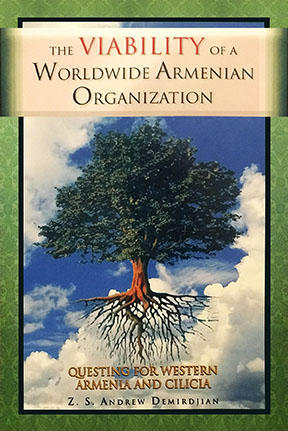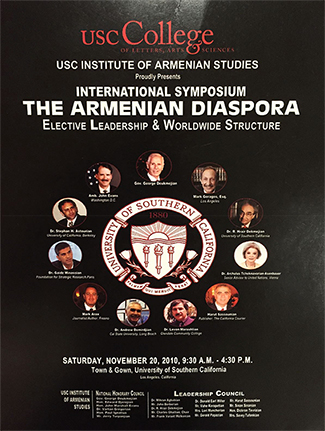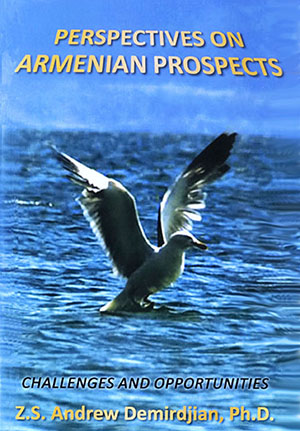Our Story - Part 2
October 2010 – The ANA Seed is Planted
The small seed of the Armenian National Association was planted back in October 2010 when a provocative and inspiring book about uniting the Armenian Spyurk was published by Dr. Z.S. Andrew Demirdjian (Professor Emeritus of Social and Behavioral Sciences, California State University, Long Beach). His book was entitled, THE VIABILITY OF A WORLDWIDE ARMENIAN ORGANIZATION: QUESTING FOR WESTERN ARMENIA AND CILICIA by Z.S. Andrew Demirdjian, Xlibris Publishing, Bloomington, Indiana, 2010.

In the forward to Dr. Demirdjian’s book, industrialist and Armenian philanthropist, Charles K. Paskerian, introduced the need to create a global organization of all Armenians everywhere in order to preserve the sacred Armenian motherland from future invasion. In these few short pages, Paskerian spoke very bluntly about the failure of the Armenian Spyurk to strengthen the Republic of Armenia and to protect their land. He contrasted the perpetual failure of the Armenian Diaspora to secure their sacred motherland with the relative success of the Jewish Diaspora to secure theirs:
“We [Armenians] are a very individualistic group of people who want to be in control and do not get along as well with one another. As a result, in most of our history, we continue to lose our lands and seem to prosper best under foreign domination.”
“The Jews have some of our same traits, but through a solid and united diaspora, they have put aside their political differences to fight physically and politically for their land.”
Mr. Paskerian continued to make a strong case for uniting the worldwide Spyurk to save Armenia.
“The Armenians of the world need to unite in solidarity through a worldwide organization to achieve a critical mass. We need to get things done efficiently and effectively for all Armenian communities around the world. This worldwide organization should be organized along professional and specialty lines to maximize the talents of our politicians, attorneys, doctors and marketing personnel throughout the world to achieve our world mission.”
Finally, Paskerian ended his forward with the most promising challenge:
“Can we do this? It is our choice. Period. And let us stop bickering amongst ourselves on minor issues…let us develop a world organization of Armenian solidarity to address our major issues.”
In the EPILOGUE (final chapter) to Dr. Demirdjian’s book, Harut Sassounian (Publisher of the California Courier Newspaper), proposed a political plan for establishing a “unity framework representing Armenians throughout the Diaspora, excluding those living in Armenia and Artsakh who are already represented by their respective governments.”
“Once established,” Sassounian explained in his EPILOGUE, “this transnational organization would create for the first time a representative body in the Diaspora with political and economic clout capable of promoting Armenian interests, preserving cultural values and defending Armenian rights worldwide.”
* To view Harut Sassounian’s complete EPILOGUE to Dr. Demirdjian’s book, please: Click Here
The lofty goal of unifying all Armenian Spyurk into one global organization to help Armenia is not a new idea, but it is an ambitious one. And after publishing his book, Dr. Demirdjian and Harut Sassounian took one big, bold and loud step to achieve it. Unfortunately, it failed.
On November 20, 2010, just five weeks after his book was published, Dr. Andrew Demirdjian joined with three of his friends Harut Sassounian, Dr. Richard H. Dekmedjian, Founding Director of the USC Dornsife Institute of Armenian Studies, and Appo Jabarian, Editor and Publisher of the USArmenia Life newspaper), to sponsor and organize a day-long event at the University of Southern California (USC). This symposium was to serve as a strategic spot for launching their worldwide initiative to unify the Spyurk as inspired my Dr. Demirdjian’s book.
Throughout the day, a sincere group of 800 Armenian activists, academics, politicians, diplomats, media representatives and various professionals had gathered in the spacious Town & Gown banquet hall on the USC campus to introduce a plan that promised to reward its members with influence and power in Armenian government affairs through direct political participation in Armenian national elections. Its mission was to exact from the modern Turkish government not only recognition of the Armenian Genocide, but to receive reparations and restitution of property and lands stolen from Armenians during the Genocide as well.
The USC symposium that day was entitled: International Symposium/The Armenian Diaspora/Effective Leadership and Global Structure.

* To view the entire printed schedule/brochure from this November 20, 2010 USC symposium please: Click Here
As a follow up to the USC symposium, Dr. Andrew Demirdjian wrote a second book entitled, PERSPECTIVES ON ARMENIAN PROSPECTS: Challenges and opportunities.

* To read a documented overview of this USC symposium along with its purpose, please reference Chapter 4 in the book PERSPECTIVES ON ARMENIAN PROSPECTS by Z.S. Andrew Demirdjian, Xlibris Publishing, Bloomington, Indiana, 2015, pp. 99-115.
* To view a video of the USC symposium from November 20, 2010 in its entirety, including Dr. Dermirdjian’s opening remarks, please Click Here
During the day-long event, a highly respected group of distinguished Armenian speakers and panelists, joined by His Excellency, John M. Evans, former U.S. Ambassador to Armenia (2004-2006), traded places at the podium on an elevated stage to address a crowded room of Armenian attendees.
Ironically, as the event progressed throughout the day, many encouraging statements were made with the intention to generate unity among the Armenian participants. However, there were an equal number of humorous attempts to make light of the fact, and even to dismiss the fact, that older generation of Armenians in Diaspora lack the leadership to achieve unity.
Then, as the event reached its end with Q&A, almost as if it was planned, a familiar fragmentation began to occur among the various Armenian factions represented in the banquet hall. Dissenters and skeptics in the audience used their short ego time at the microphones to question the intentions of the organizers and to sow discord by diminishing the effort. Wisely, Dr. Richard Dekmedjian used his microphone in a heroic but ill-fated attempt to quell the dissent, and the symposium was summarily closed.
